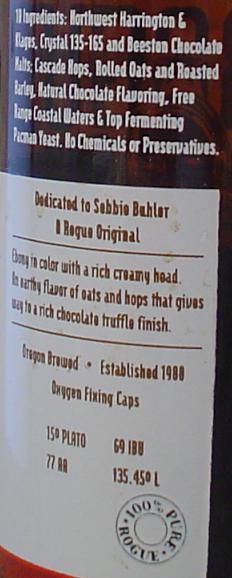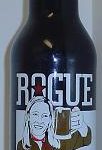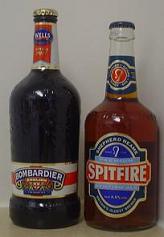I mented in a post below how I am amazed how the LCBO – Liquor Control Board of Ontario – cannot stock shelves better than a decent corner store in the USA. With the monopoly of 12 million people behind it, the LCBO is the greatest buyer of beer, wine and spirits in the world. The biggest used to be Sweden until that was privatized. Now it is where I live. What drives me nuts about it is the LCBO’s ability to master routes of distribution, bring in wines that sell for 20 USD and put them on our dinner tables for 12 Canuck bucks yet they cannot go out and obtain good ales and lagers with the same intellegence. It sells Genessee Ice but not Cream. That in itself is an indictment.
Another is the mere presence of a product by Rogue, one of the great US brewers, without sharing shelf space with five or ten others. At Halloween we get a small number of Dead Guy Ale and in March their St. Patrick’s day issue dry stout. For the rest of year, nuttin’.
So it was with excitement I saw the quart of Rogue’s Chocolate Stout before me. Rogue is a producer of perfection. Click on the picture below right and see for yourself the pride in product – they actually tell you what’s in it. They tell you what happens when they put what’s in it together: 19 IBU is a measure of bitterness, “international bitterness units”; 15º plato is a measure of potential alcohol strength at the start of fermentation; and 135.45º L is a measurement of darkness of hue. This tells you is is moderately strong, quite bitter and very dark.
What it does not tell you in itself is its loveliness. This beer could be reduced over low heat to make a syrup you could bake into a cake, it could stand alone as a marinade for ribs and it could fill an evening with friends whether in front of the TV or as a fine dessert over nuts and blue cheese. It is fulsome in its chocolate flavour but bitter like a fine dessert chocolate cheese cake, the bitterness laying entirely in the natural hops chosen by the brewer – woodsy, rich. The style is an odd one little brewed, being an offshoot (maybe what apple orchardists would call a “sport”) of oatmeal stout. Youngs of England has a famous one, Double Chocolate Stout, that takes pride in its natural manipulation of the barley, through malting and roasting to create chocolate malt, a nuance of flavour that needs no extract or kidding one’s self. Of its own version, Rogue says:
The recipe for Rogue Chocolate Stout was created several years ago for export to Japan. The exported twelve ounce Chocolate Bear Beer bottle label is in Kanji and features a teddy bear with a pink heart on his belly. Chocolate Stout was released for Valentine’s Day in 2001 in a twenty-two ounce bottle for the US market. The label features a Roguester (Sebbie Buhler) on the label. The bottled of Chocolate Stout is available on a very limited basis in the US, so get it while you can! Hedonistic! Ebony in color with a rich creamy head. The mellow flavor of oats, chocolate malts, and real chocolate are balanced perfectly with the right amount of hops for a bittersweet finish…. .
This is an amazing drink. Painted bottle, too. Beauty. Beer Advocatonians approve.




